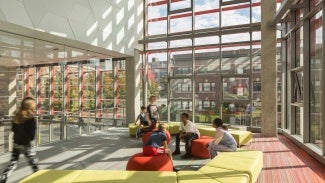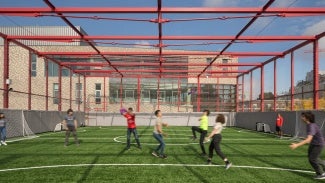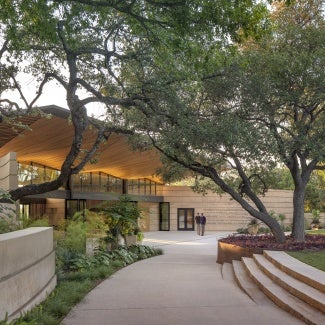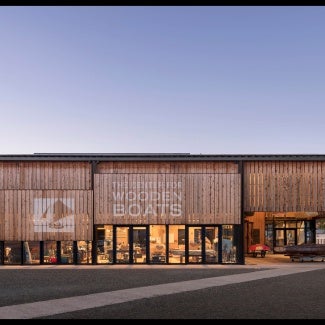Seattle Academy of Arts and Sciences Middle School
The award-winning contemporary architecture of the Seattle Academy of Arts and Sciences Middle School harnesses verticality to leverage a limited site and connect the academy more deeply to the surrounding community.
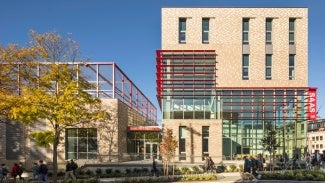
Project highlights: Seattle Academy of Arts and Sciences Middle School
- Architect: LMN Architects
- Owner: Seattle Academy of Arts and Sciences
- Location: Seattle
An evolution of the Seattle Academy of Arts and Sciences’ urban campus, this new middle school harnesses verticality to leverage a limited site and connect the academy more deeply to the surrounding community. Sitting at a busy Seattle intersection, the six-story academic volume offers students a supportive learning environment that encourages independence, experimentation, and a new dialogue between the school’s curriculum and the Capitol Hill neighborhood.
The school’s core academic spaces comprise the upper floors of the new 69,900-square-foot building, while its lower floors accommodate athletic activities, administration, music instruction, and a makerspace. In addition, the school’s gym and rooftop playfield provide valuable space for physical activity, which is often overlooked in urban contexts. Adjacent academy buildings can be accessed via the lower floors, underscoring the middle school’s role as a vital connector on campus.
Each grade occupies a floor within the middle school, and classrooms, the fundamental building block of the program, are organized around collaborative learning spaces that support project-based learning and cross-disciplinary discovery. Glazing in each classroom creates a porous and transparent connection between both spaces, allowing activities to move easily between them. The collaborative spaces are designed as a series of stepped double-height volumes that cascade between floors, advancing a sense of visual and physical connection between grades.
While the collaborative spaces are key to the academy’s educational mission, they also form the primary architectural expression of the building. Its exterior is wrapped with brick and punctuated with swaths of transparency that are directly related to the collaborative spaces contained within. Glazing tumbles down the exterior of the building, ending at a primary gathering space that anchors the intersection. An outdoor space at the entry is a welcoming, street-level gathering space for students that also provides an amenity for the community.
The school’s design is reflective of the academy’s commitment to a socially and ecologically responsible community, and its sustainable features actively engage the student body. Building analysis modeling employed by the design team optimized daylight, solar exposure, and natural ventilation, while the multistory classroom bar, organized north to south, maximizes solar heat gain in the winter and relies on sunshades to limit heat gain in the summer. Mechanically assisted natural ventilation and passive cooling are incorporated in the learning spaces, which are also equipped with indicator lights that empower students to manage classroom operation modes.
The middle school is a model for how Seattle can densify sustainably. It uses 64% less energy than comparable schools, and all five of its facades work together to support its sustainability goals. In addition, the design promotes regional vegetation, street trees, and ample natural light that reaches the parking garage and below-ground music spaces by taking advantage of the site’s steep grade.
Project team & Jury
Owner’s Representative: Seneca Group
Contractor: GLY Construction
Civil & Structural Engineer: Coughlin Porter Lundeen, Inc.
Landscape Architect: Swift Company, LLC
Lighting Design: dark | light consulting, LLC
MEP Engineer: PAE Consulting Engineers, Inc.
Audiovisual & Technology: PAE Consulting Engineers, Inc.
Acoustical Engineer: Stantec
Food Service Design: JLR Design
Envelope Consultant: Morrison Hershfield
Playfield Consultant: DA Hogan
Ashley Wilson, FAIA, Chair, Ashley Wilson Architect, Alexandria, Va.
Jose Leo Arango, Assoc. AIA, EYP, District of Columbia
Randall Deutsch, FAIA, University of Illinois at Urbana-Champaign School of Architecture, Champaign, Ill.
Gabriel Ignacio Dziekiewicz, AIA, DesignBridge, Chicago
Teresa Jan, AIA, Multistudio, San Francisco
Luis Nieves-Ruiz, East Central Florida, Regional Planning Council, Orlando, Fla.
Zakiya Wiggins, AIA, LS3P, Raleigh, N.C.
The 2023 Architecture program celebrates the best contemporary architecture regardless of budget, size, style, or type. These stunning projects show the world the range of outstanding work architects create and highlight the many ways buildings and spaces can improve our lives.
Sixteen projects showcase the best contemporary architecture.

